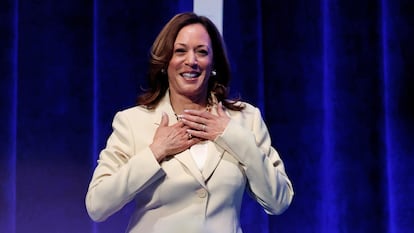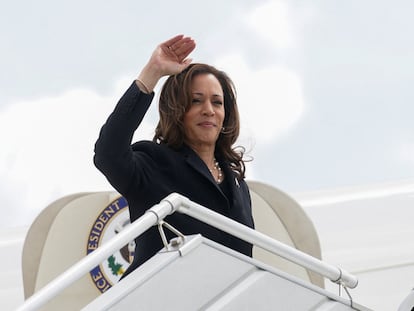Kamala Harris has always identified as Indian American and Black
The vice president, whose mother was born in India and whose father was from Jamaica, has always identified as both races, despite Trump’s allegations

Former president Donald Trump falsely claimed that Vice President Kamala Harris has only recently begun identifying as Black, and that until a few years ago “she was only promoting Indian heritage.” That’s nonsense.
Harris, whose mother was born in India and whose father was from Jamaica, has always identified as both Indian American and Black.
Trump appears to be trying to resurrect bogus social media claims that gained some traction back in 2020 after Harris was tapped as Joe Biden’s running mate. The posts claimed that when Harris became a senator in 2017, she only identified as an Indian American, and that she only later began identifying as Black for political gain. It was nonsense then, too.
At the annual convention of the National Association of Black Journalists on July 31, ABC News’ Rachel Scott asked Trump if he thought Harris was “only on the ticket because she is a Black woman.”
“So I’ve known her a long time, indirectly, not directly, very much,” Trump said. “And she was always of Indian heritage, and she was only promoting Indian heritage. I didn’t know she was Black until a number of years ago, when she happened to turn Black, and now she wants to be known as Black. So I don’t know, is she Indian or is she Black?”
“I respect either one,” Trump continued. “But she obviously doesn’t, because she was Indian all the way and then all of a sudden she made a turn, and she became a Black person. I think someone should look into that, too.”
As we said, there is ample evidence that Harris, now the presumptive Democratic presidential nominee, has for decades identified as both Indian American and Black, reflecting her biracial parentage.
In her 2019 autobiography, The Truths We Hold: An American Journey, Harris describes being brought up in a multicultural home. Harris’ parents divorced when she was a young girl, and while her father “remained a part of our lives,” it was “really my mother who took charge of our upbringing,” she wrote.
“Our classical Indian names harked back to our heritage, and we were raised with a strong awareness of and appreciation for Indian culture,” Harris wrote.
But, she added, “My mother understood very well that she was raising two Black daughters. She knew that her adopted homeland would see Maya and me as Black girls, and she was determined to make sure we would grow into confident, proud black women.”
A May 25, 2016, profile of Harris in the New York Times Magazine states, “She [Harris’ mother] brought up her daughters, in the late 1960s and early 1970s, in a Black neighborhood in Berkeley, sharing a house with a friend who ran a small preschool. ‘She had two Black babies, and she raised them to be two Black women,’ Harris says of her mother’s choice of community.”
In her autobiography, Harris recounted as a child regularly attending a “pioneering Black cultural center” that held performances by “some of the most prominent Black thinkers and leaders of the day.” Some of her greatest heroes, she said, were African American lawyers “Thurgood Marshall, Charles Hamilton Houston, Constance Baker Motley – giants of the civil rights movement.”
Following the example of Marshall, who went to law school at Howard University, Harris also decided to attend the historically Black university in Washington, D.C., as an undergraduate. At Howard, Harris joined the Alpha Kappa Alpha Sorority, which bills itself as “America’s premier Greek-letter organization for African American women.”
An alumni profile of Harris in Howard Magazine in the fall of 2016 noted that Harris was “reared by her mother, a scientist and immigrant from India” and that “Harris said being on Howard’s campus ‘during those formative years’ was central to her development as a Black person.”
After graduating from Howard in 1986, Harris returned to Oakland, California, and went to law school at UC Hastings College of Law (now UC San Francisco Law).
At UC Hastings, she wrote in her autobiography, “I was elected president of the Black Law Students Association (BLSA) during my second year in law school. At the time, Black students were having a harder time finding employment than white students, and I wanted to change that. As BLSA president, I called the managing partners of all the major law firms and asked them to send representatives to a job fair we were hosting at a hotel.”
While serving in the U.S. Senate, Harris was a member of the Congressional Black Caucus.
On occasions when she has spoken before a largely Indian American audience, she has sometimes emphasized that part of her heritage — as one would expect. Speaking at the Indian American Impact Summit in May, for example, Harris talked about her Indian heritage while encouraging Indian Americans to participate in the political process and to run for elected office.
“You are going to find yourself, invariably, in rooms where you are the only one who looks like you,” Harris said to the predominantly Indian American audience. “And what I then say to you each, look around this room and hold on to this image. And remember then when you walk into those rooms … you remember you are not alone, we are all there with you.”
Trump and Campaign double down on falsehood
At a Trump rally in Pennsylvania after his remarks at the NABJ convention, the campaign posted on a large video screen behind the stage the headline of a Nov. 9, 2016, AP story that Business Insider published, that read, “California’s Kamala Harris becomes first Indian-American U.S. senator.”
That’s entirely accurate, of course. She was.
An AP story published the same day, Nov. 9, 2016, presents a more complete description, stating, “Harris will enter the chamber as the first Indian woman elected to a Senate seat and the second Black woman, following Carol Moseley Braun, who served a single term after being elected in 1992.”
Similarly, when Harris was elected as San Francisco district attorney in December 2003, the Associated Press reported, “Harris, a former girlfriend and political protégé of Mayor Willie Brown, will be the first female district attorney in the city’s history and the first Black to hold the office in California.” A month later, Jet magazine ran a story under the headline, “Kamala Harris is San Francisco’s First Black District Attorney.” Both stories were obtained from the news archives, LexisNexis.
After Trump made his comments, conservative commentator Laura Loomer posted on X a reprint of Harris’ birth certificate and wrongly claimed it proved Harris is “a liar” and that “Donald Trump is correct. Kamala Harris is NOT black and never has been.” Loomer noted, “Nowhere on her birth certificate does it say that she is BLACK OR AFRICAN.”
That last part is true. According to a copy of Harris’ birth certificate posted by the Mercury News in August 2020, Harris’ race is not recorded — because there is no box for it. The certificate notes that Harris’ mother, who was living in Berkeley, California, was born in India. Where certificate form asks for the “color or race of mother,” it is marked “Caucasian.”
That’s not surprising. A 1995 document from the Office of Management and Budget titled “Standards for the Classification of Federal Data on Race and Ethnicity” notes that in decennial censuses, “There have been many changes in the broad racial categories, the specific components of the categories, and whether data on ethnicity were collected. Asian Indians, for example, were counted as ‘Hindus’ in censuses from 1920 to 1940, as ‘White’ from 1950 to 1970, and as ‘Asians or Pacific Islanders’ in 1980 and 1990.” Harris’ birth certificate is from her birth year, 1964. She was born in Oakland.
Under the “color or race of father,” the certificate states, “Jamaican.” The form also notes that Harris’ father, Donald J. Harris, is a native of Jamaica. While the birth certificate makes no note of it, Donald Harris is Black.
In other words, Kamala Harris is both Indian American and Black.
Trump amplified Loomer’s bogus post by re-posting it on his social media platform. He also posted an old photo of Harris with Indian relatives in traditional Indian garb. Trump commented, “Your warmth, friendship, and love of your Indian Heritage are very much appreciated.”
Additionally, Trump posted a recent cooking video Harris made with Indian American actress Mindy Kaling. Trump commented, “Crazy Kamala is saying she’s Indian, not Black. This is a big deal. Stone cold phony. She uses everybody, including her racial identity!”
In the video, Kaling asks, “You are Indian?” to which Harris enthusiastically replies, “Yes, yes.”
“I don’t know that everybody knows that,” Kaling says. Moments later, when Kaling notes that they both have family from south India, Harris replies, “You look like the entire one-half of my family.” And that line is exactly the point. It is a part of her heritage from her mother’s side.
In a February 2019 interview with a morning radio show called The Breakfast Club, Harris addressed questions about the “legitimacy” of her blackness. “I think they don’t understand who Black people are,” she said. “Because if you do, if you walked on Hampton’s campus, or Howard’s campus or Morehouse, or Spelman or Fisk, you would have a much better appreciation for the diaspora, for the diversity, for the beauty in the diversity of who we are as Black people. So I’m not going to spend my time trying to educate people about who Black people are.”
In remarks at a convention for the Black sorority Sigma Gamma Rho, Harris addressed Trump’s claims at the NABJ event, saying “it was the same old show — the divisiveness and the disrespect.”
This article was originally published by FactCheck.org on August 1, 2024.
Sign up for our weekly newsletter to get more English-language news coverage from EL PAÍS USA Edition
Tu suscripción se está usando en otro dispositivo
¿Quieres añadir otro usuario a tu suscripción?
Si continúas leyendo en este dispositivo, no se podrá leer en el otro.
FlechaTu suscripción se está usando en otro dispositivo y solo puedes acceder a EL PAÍS desde un dispositivo a la vez.
Si quieres compartir tu cuenta, cambia tu suscripción a la modalidad Premium, así podrás añadir otro usuario. Cada uno accederá con su propia cuenta de email, lo que os permitirá personalizar vuestra experiencia en EL PAÍS.
¿Tienes una suscripción de empresa? Accede aquí para contratar más cuentas.
En el caso de no saber quién está usando tu cuenta, te recomendamos cambiar tu contraseña aquí.
Si decides continuar compartiendo tu cuenta, este mensaje se mostrará en tu dispositivo y en el de la otra persona que está usando tu cuenta de forma indefinida, afectando a tu experiencia de lectura. Puedes consultar aquí los términos y condiciones de la suscripción digital.
More information
Archived In
Últimas noticias
Most viewed
- Reinhard Genzel, Nobel laureate in physics: ‘One-minute videos will never give you the truth’
- Oona Chaplin: ‘I told James Cameron that I was living in a treehouse and starting a permaculture project with a friend’
- Pablo Escobar’s hippos: A serious environmental problem, 40 years on
- Charles Dubouloz, mountaineering star, retires at 36 with a farewell tour inspired by Walter Bonatti
- Why we lost the habit of sleeping in two segments and how that changed our sense of time










































